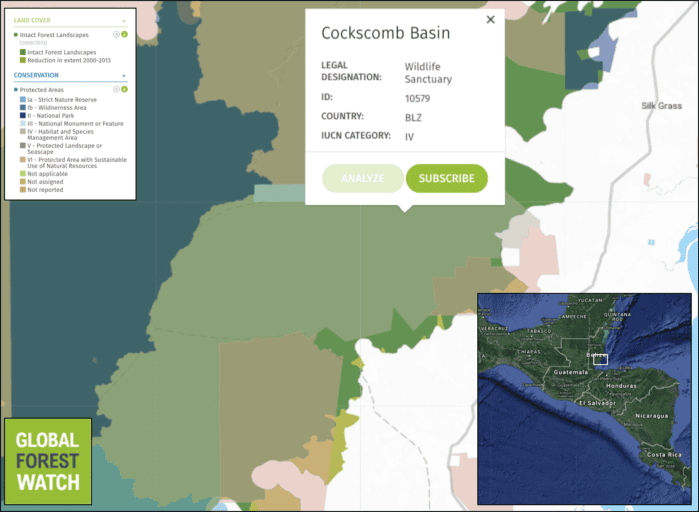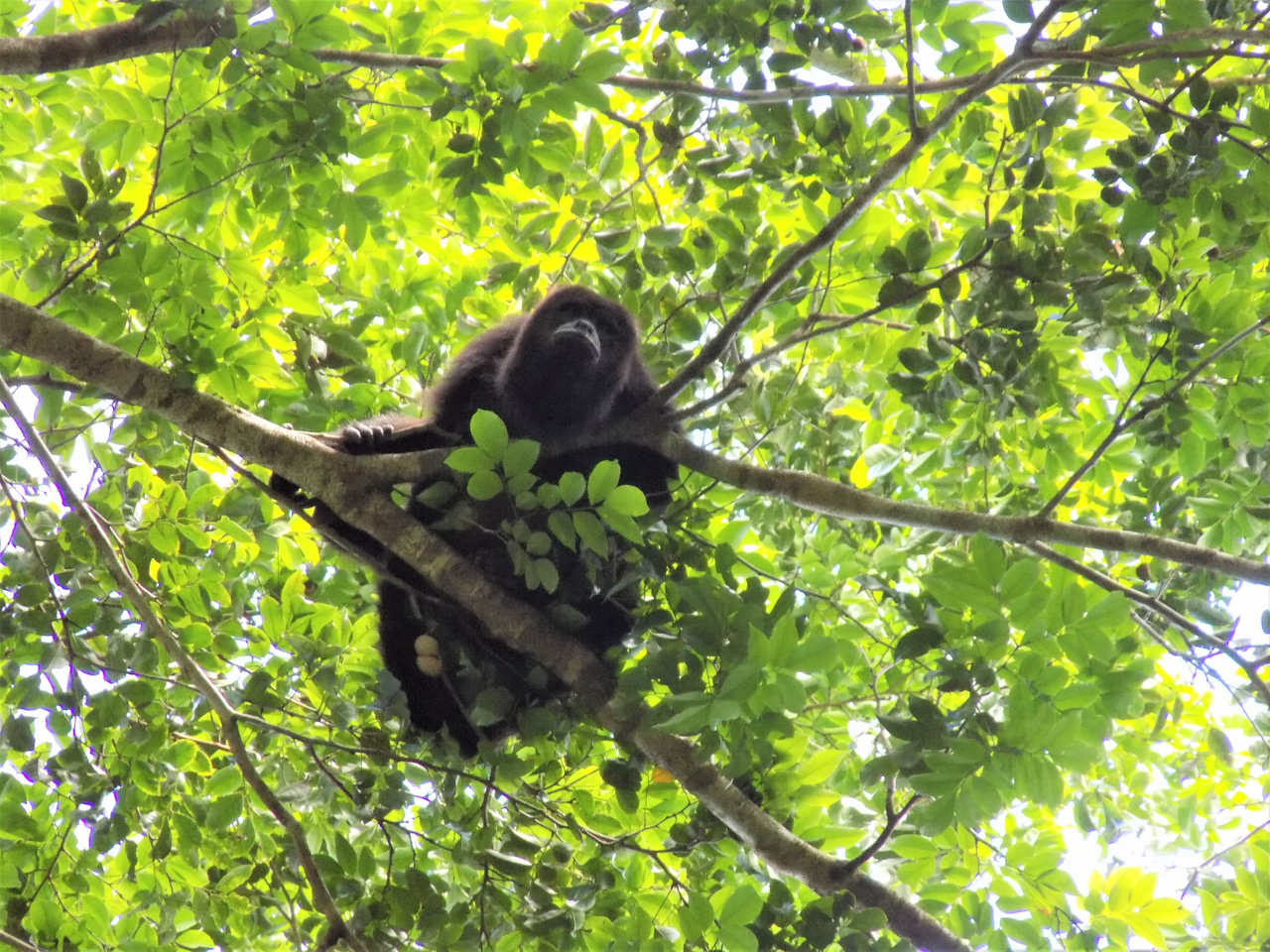- Disease, hurricanes and hunting wiped out the native howler monkeys living in the Cockscomb Basin by the 1970s.
- Between 1992 and 1994, 62 black howler monkeys (Alouatta pigra) were relocated from a nearby reserve.
- After surveying the Cockscomb Basin Wildlife Sanctuary in March and April, scientists figure there are at least 170 howler monkeys – and perhaps many more – living all over the 51,800-hectare (128,000-acre) preserve.
The calls of howler monkeys, once wiped out in a Central American forest known as the Cockscomb Basin, now ring out in the canopy, and the scientists responsible couldn’t be happier.
“As conservationists, we’re constantly trying to stop things from disappearing. We’re always playing for a tie,” said Scott Silver, a tropical biologist with the Wildlife Conservation Society (WCS).
Silver was part of a team that reintroduced black howler monkeys (Alouatta pigra) to the Cockscomb Basin Wildlife Sanctuary two and a half decades ago. Then, in March and April 2017, he and his colleagues from WCS and the Belize Audubon Society returned and surveyed the area in collaboration with the sanctuary’s wardens. They confirmed that the howler monkey population has grown and spread throughout the 51,800-hectare (128,000-acre) wildlife sanctuary in, to his knowledge, the most successful translocation of a primate population yet.
“It’s nice to gain yardage as opposed to trying to just hold on,” Silver said by telephone from his office in New York City, where he directs the Queens Zoo.

The black howler monkey is currently listed as Endangered by the IUCN, with the most significant threats coming from habitat loss and hunting, either for meat or the pet trade. Between 1992 and 1994, a team of scientists, including Silver, released 14 troops of 62 animals in the Cockscomb Basin.
“That in itself was a pretty unique project,” Silver said. In preparation, they had followed the monkeys for 4 months at the Community Baboon Sanctuary about 80 kilometers (50 miles) north of the basin to pick out the family groups that would make the trip.
“We released intact family units because we thought that that would enable them to adjust better and have some social support at the same time,” Silver said.
Members of the team then kept tabs on the families for a year after that. Silver took the opportunity to follow some of the groups and look at their feeding habits. His wife, fellow tropical biologist Linde Ostro, studied the changes to their social structures and the impact the Cockscomb habitat had on their home ranges.

The idea, conceived by WCS scientist Fred Koontz and Community Conservation Consultants founder Rob Horwich, was to bring howler monkeys back to one of their former stomping grounds. Just a few decades prior, they’d been swinging from the trees in the Cockscomb Basin, serving as critical cogs in the coastal rainforest ecosystem there.
But in 1961 Hurricane Hattie swept through the western Caribbean, causing $60 million (about $489 million in today’s dollars) in damages. The winds, gusting to 322 kilometers per hour (200 miles per hour), took out around 75 percent of the capital city of British Honduras, as Belize was then known, according to a report in the journal Monthly Weather Review.
The country’s forests didn’t fare well either. 1961’s most powerful hurricane flattened about 90 percent of the trees in the Cockscomb Basin, which lies south of Belize City. Once-plentiful howler monkeys, already reeling from a yellow fever outbreak in the 1950s and overhunting, were decimated, and by the 1970s, the Cockscomb fell silent – at least to the roars and grunts that make these monkeys famous.
Slowly, however, the forest came back. In the early 1980s, biologist Alan Rabinowitz discovered that the Cockscomb held a large population of jaguars (Felis onca coati). That led to the basin’s designation as a forest reserve in 1984, and later as a sanctuary and jaguar reserve where, it was hoped, visitors could come to see wildlife.
But, Silver said, “It’s very hard to see jaguars.” So the team, led by Koontz and Horwich, thought that bringing howler monkeys back might be a good move.
“We wanted to enhance the experience of people who come to visit,” Silver said.

On this recent trip to check on the monkeys after 25 years, he said he was heartened to see tourists training binoculars on the canopy to spot howler monkeys.
“It reminded me of Yellowstone or what you’d see on African safaris.” The sanctuary is also home to tapirs, deer and other cats.
In their latest visit, Silver and Ostro spent a month between them in the basin, searching for and counting monkeys, listening for their calls, and keeping their noses open for the scent of the monkeys’ “very distinctive” urine.
In all, they spotted 15 groups and laid eyes on 72 individual monkeys. They also figure that they found signs of at least another 100 animals, representing perhaps another 21 groups, Silver said. Their investigations also revealed that the howler monkey population has spread at least 20 kilometers (12.4 miles) from the release site.
“Just about any place that I searched or I inquired about, people were hearing monkeys,” he said. “I was surprised by the extent of their dispersal.”
Though there might be lessons from this success story that translate to other species, Silver points out that the story of howler monkeys is a unique case. They weren’t moving into other animals’ territory, which limited the competition the first pioneer howlers had to contend with. And there was a good chance that the monkeys would continue to have the area all to themselves. Most of the Cockscomb Basin is lowland, broadleaf rainforest, but it’s surrounded by mountains that stretch to 1,160 meters (3,806 feet) high, which howler monkeys from outside won’t cross.

They are also well-suited to the strain of translocation, Silver said.
“Howler monkeys lend themselves well to translocation in the sense that they’re energy minimizers,” he said. “Under stress, they slow down instead of speed up.”
Thrown back into their native environment, they’re now thriving, and that’s beginning to have an impact on the forest itself. Howler monkeys eat leaves, fruit, flowers and nuts, and, as important seed dispersers, they play a critical role in shaping the tree species makeup of the forest.
“I love the idea that for the last 25 years the forest is being affected in a positive way,” Silver said, “back to the way it was for hundreds if not thousands of years before the howler monkeys disappeared.”
And all signs indicate that it will stay that way.
“Nothing’s for sure, but I think in this case, we could say that we’ve done the best anybody could expect,” Silver said. He mused that perhaps he’ll return to the Cockscomb Basin in the future, just to make sure the coming generations of howler monkeys are doing OK.
“We joke that maybe we’ll come back when it’s the 50-year anniversary, and these guys can wheel me around.

FEEDBACK: Use this form to send a message to the author of this post. If you want to post a public comment, you can do that at the bottom of the page.
CITATIONS
- Dunn, G. E., & Miller, B. I. (1962). The hurricane season of 1961. Monthly Weather Review, 90(3), 107-119.
- Greenpeace, University of Maryland, World Resources Institute and Transparent World. “Intact Forest Landscapes. 2000/2013” Accessed through Global Forest Watch on 10 May 2017. www.globalforestwatch.org
- Hansen, M. C., P. V. Potapov, R. Moore, M. Hancher, S. A. Turubanova, A. Tyukavina, D. Thau, S. V. Stehman, S. J. Goetz, T. R. Loveland, A. Kommareddy, A. Egorov, L. Chini, C. O. Justice, and J. R. G. Townshend. 2013. “High-Resolution Global Maps of 21st-Century Forest Cover Change.” Science 342 (15 November): 850–53. Data available on-line from:http://earthenginepartners.appspot.com/science-2013-global-forest. Accessed through Global Forest Watch on 10 May 2017. www.globalforestwatch.org
- IUCN and UNEP-WCMC (2017), The World Database on Protected Areas (WDPA) [On-line], April, 2017, Cambridge, UK: UNEP-WCMC. Available at: www.protectedplanet.net. Accessed through Global Forest Watch in May 2017. www.globalforestwatch.org
- Ostro, L. E., Silver, S. C., Koontz, F. W., Horwich, R. H., & Brockett, R. (2001). Shifts in social structure of black howler (Alouatta pigra) groups associated with natural and experimental variation in population density. International Journal of Primatology, 22(5), 733-748.
- Ostro, L. E., Silver, S. C., Koontz, F. W., Young, T. P., & Horwich, R. H. (1999). Ranging behavior of translocated and established groups of black howler monkeys (Alouatta pigra) in Belize, Central America. Biological Conservation, 87(2), 181-190.
- Rabinowitz, A. R., & Jr, B. G. (1986). Ecology and behaviour of the jaguar (Panthers onca) in Belize, Central America. Journal of Zoology, 210(1), 149-159.
- Silver, S. C., Ostro, L. E. T., Yeager, C. P., & Horwich, R. (1998). Feeding ecology of the black howler monkey (Alouatta pigra) in northern Belize. American Journal of Primatology, 45(3), 263-279.
